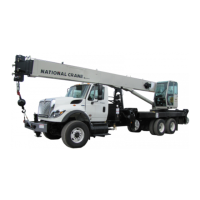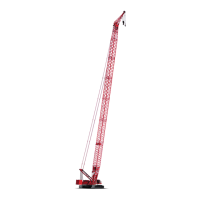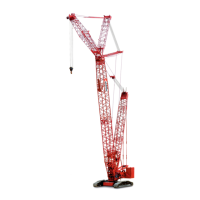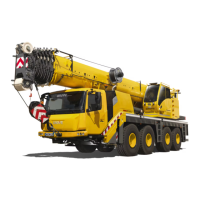National Crane 1-21-2019 Control # 104-07 2-15
1400A SERVICE MANUAL HYDRAULIC SYSTEM
Hydraulic Valves
Directional Control Valve
The main control valve controls the hoist, lift cylinder, and
telescope cylinder. The valve is located in the turret.
Inspection
Inspect the control valve for visible damage, binding spools,
and evidence of leakage. If excessive internal leakage is
suspected during operation with a spool in its center position,
it is possible that the area between the spool and working
section bore of the valve body is worn beyond serviceable
limits. If this condition exists, the spool and body must be
replaced as an assembly.
Valve Leakage
Dripping hydraulic oil indicates some type of external
leakage. The machine should be removed from service for
immediate repairs. External leaks sometimes develop at
fittings and seals. Spool seals are susceptible since they are
subject to wear. Seals may be damaged by temperatures
that are too high, or by dirt or paint accumulation on the
spool. Damaged seals must be replaced.
A component functioning at reduced efficiency may indicate
that the control valve for that component is leaking internally.
If preliminary check-out reveals that adequate volume is
being supplied to the affected valve bank, relief valves are
properly adjusted, and the component is not at fault, check
the valve for scored or worn parts. Scoring is a usually sign of
contamination (external contamination by dust or internal
contamination by debris from deteriorating components or
oxidized hydraulic oil). Scored or severely worn valve
components must be replaced.
Check valves in the control valve are designed to permit a
flow of hydraulic oil in one direction only. If a piece of dirt or
rust has worked its way into the check valve and lodges
between the poppet and seat, it will keep the valve open and
allow a return flow of hydraulic oil. Clean the valve and check
that the hydraulic system filter is still serviceable.
Binding Spools
Some of the most common causes for stiff spool movement
or jammed spool action are system overheating, excessive
pressure, contaminated or deteriorated hydraulic oil, or
warped mountings. When scorched or deteriorated hydraulic
oil or contamination is the cause, flush the system and
replenish with clean hydraulic oil. If the spool bores are badly
scored or galled, the valve must be removed for servicing.
Warping occurs when mounting plates are not level or they
become distorted from machine damage. The valve can be
shimmed level to correct this problem.
Check the valve for rust. Rust or dirt collecting on the valves
can prevent free movement of the spool, and keep it from the
true center position. Excessive system pressure can create
both internal and external leaks in valves that are otherwise
sound. Only qualified technicians using the correct
equipment should make pressure adjustments when
pressure adjustments are needed.
Main Control Valve
Removal
1. Tag and disconnect the hydraulic lines from the valve.
2. Cap the lines and plug ports.
3. Loosen and remove the valve mounting bolts and
remove the valve bank.
Installation
1. Bolt the directional control valve to the enclosure.
2. Reinstall the hydraulic lines as per removal tags.
Functional Check
1. Start the engine and run it at normal speed.
2. Operate the control levers of the valve bank(s). Check
for smooth operation of cylinders and motors.
3. Check the valve bank and lines for leakage. Make
repairs as needed.
RCL Dump Valve
The purpose of the RCL dump valve is to disable those
functions which worsen an overload condition. To check the
RCL system, do the following:
1. Remove fuse F6 from the mini fuse panel to disconnect
power to the RCL.
2. Start the engine.
3. Try to telescope the boom out, lower the boom, hoist up.
Verify none of these functions work.
4. Shut down the engine. Reinstall fuse F6.
5. Telescope the boom out, lower the boom, hoist up. Verify
all of these functions work.
6. Check for leaks and repairs as needed.
Hydraulic Remote Control Valve
The crane functions are controlled by hydraulic remote
controllers (HRC) on the armrest of the operators seat which
controls the hydraulic remote control valve located on the
rear of the superstructure turntable. See (Figure 2-10). The
controllers operate from a load sense pilot pressure which is
generated by the pump and controlled by the main control
valve. Pilot pressure is applied to the bonnets on each side
of the control valve spools to shift the spool in the required
direction.
Fo
r
Reference
Only

